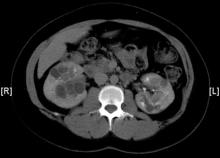The CT scan showed bilateral polycystic kidneys. Polycystic kidney disease (PKD) is a manifestation of a group of inherited disorders resulting in renal cyst development. In the most common form, autosomal-dominant polycystic kidney disease (ADPKD), extensive epithelial-lined cysts develop in the kidney; in some cases, abnormalities also occur in the liver, pancreas, brain, arterial blood vessels, or a combination of these sites.
The current role of therapy in PKD is to slow the rate of progression of renal disease and minimize symptoms. In clinical trials, neither protein restriction nor tight blood pressure control decreased the decline in glomerular filtration rate. However, in a UK population study, increasing coverage (from 7% to 46% of the population prescribed an antihypertensive agent) showed a trend toward decreasing mortality. Increased intensity of antihypertensive therapy was associated with decreasing mortality in people with ADPKD.
For episodes of gross hematuria, bed rest, analgesics, and hydration are recommended. Blood pressure should be controlled to reduce the risk of associated cardiovascular disease. Treat infection as early as possible. If an infected cyst is suspected, agents that penetrate cysts such as trimethoprim-sulfamethoxazole and ciprofloxacin are used.
Photo courtesy of Michael Freckleton, MD. Text for Photo Rounds Friday courtesy of Richard P. Usatine, MD. This case was adapted from: Smith M. Polycystic kidneys. In: Usatine R, Smith M, Mayeaux EJ, Chumley H. Color Atlas of Family Medicine. 2nd ed. New York, NY: McGraw-Hill; 2013:436-440.
To learn more about the Color Atlas of Family Medicine, see: http://www.amazon.com/Color-Family-Medicine-Richard-Usatine/dp/0071769641/
You can now get the second edition of the Color Atlas of Family Medicine as an app by clicking this link: http://usatinemedia.com/


